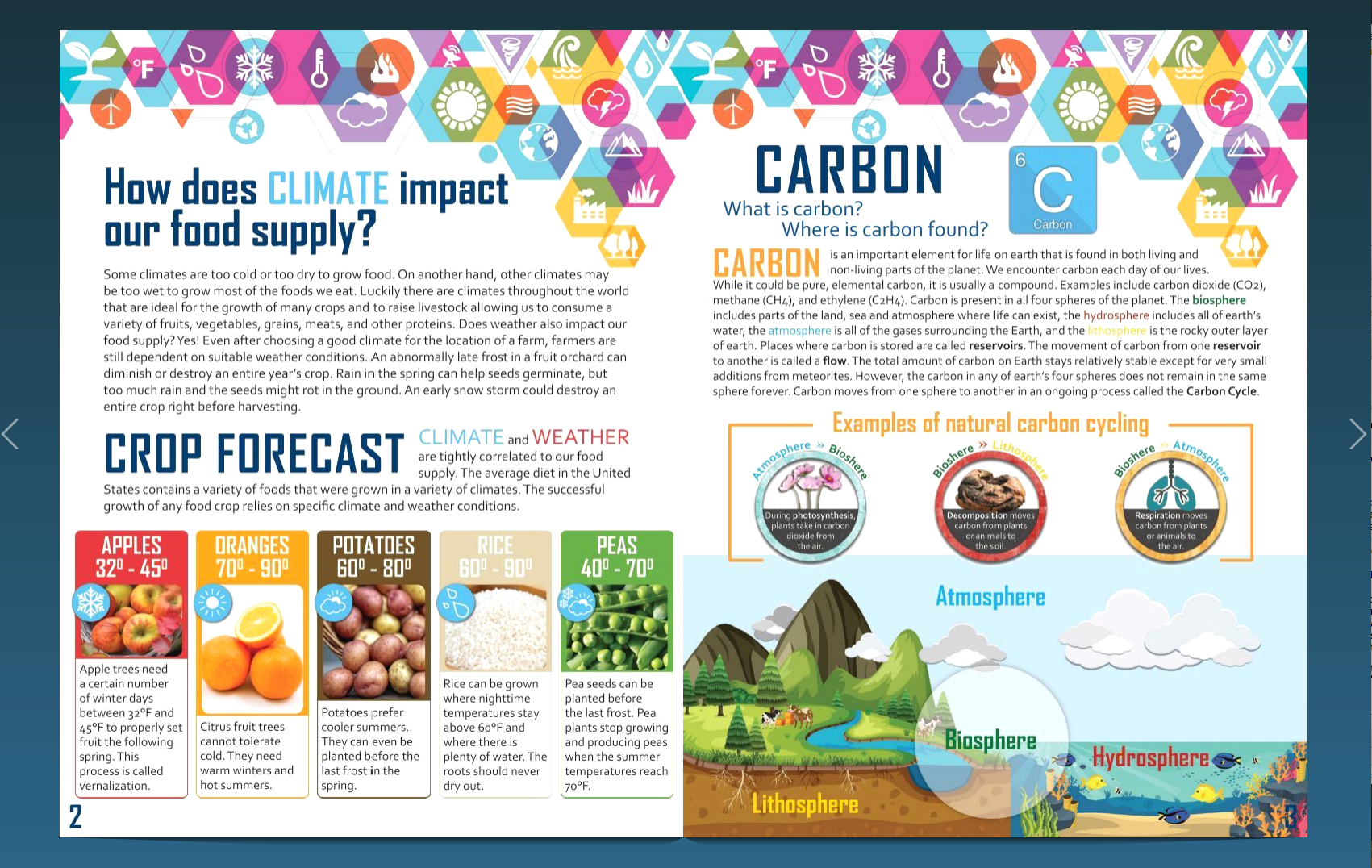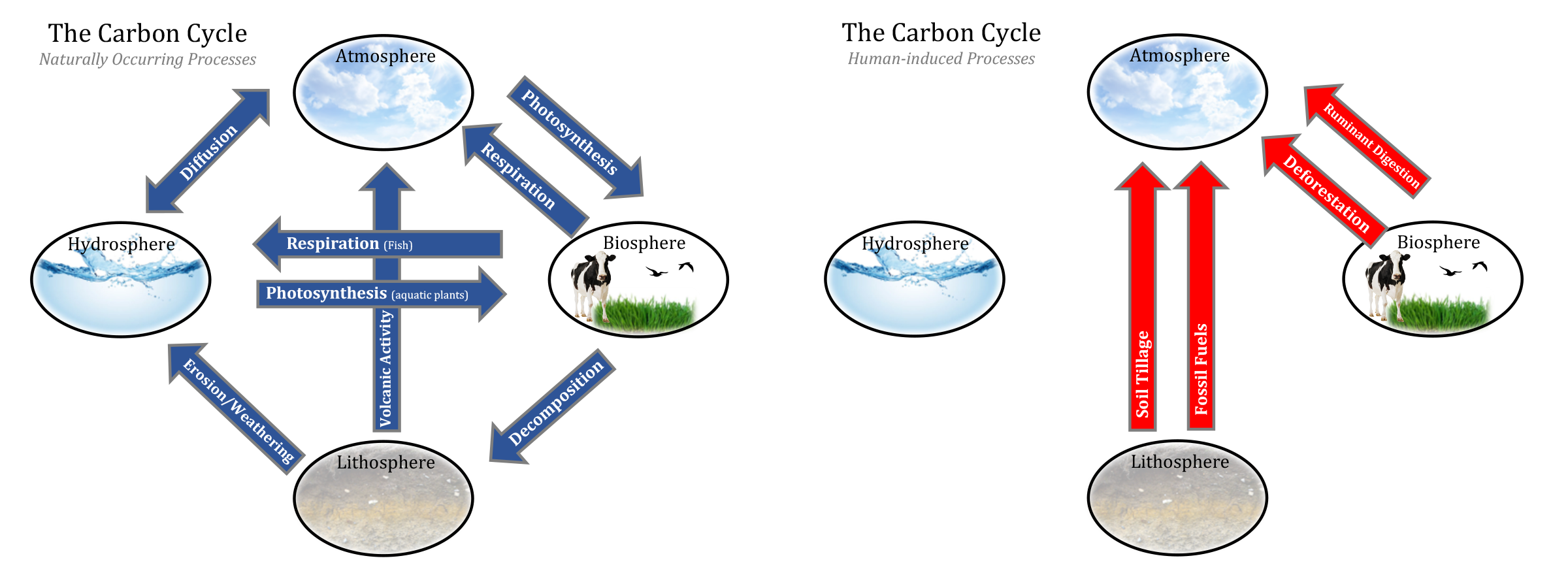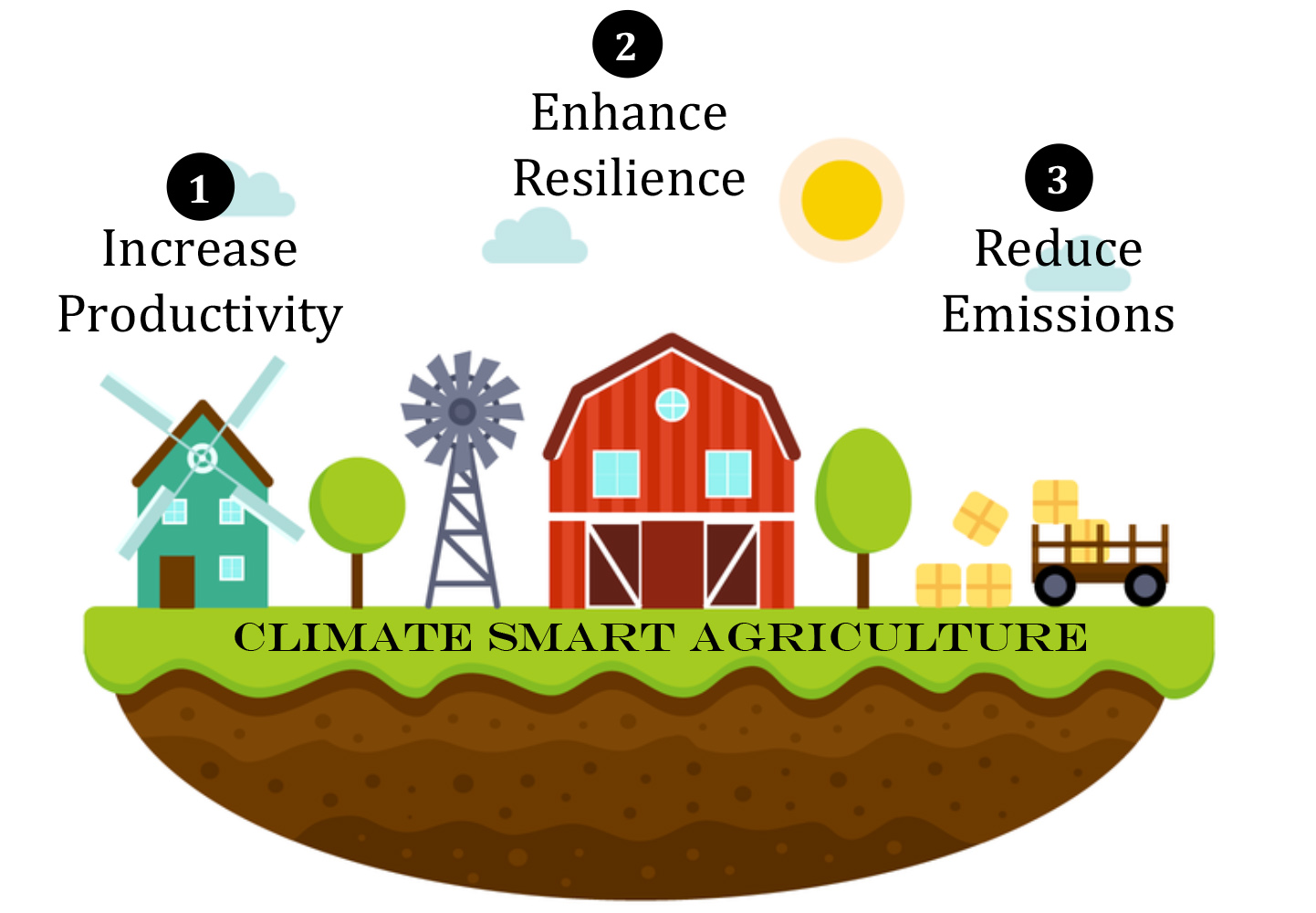 Relevancy and Engagement
dc.agclassroom.org
Relevancy and Engagement
dc.agclassroom.org
The Carbon Cycle and Climate Smart Agriculture
Grade Level
Purpose
Students explore the carbon cycle, evaluate natural and human-induced activities that drive the carbon cycle, and discover climate smart agricultural practices that can be used to produce our food. Grades 9-12
Estimated Time
Materials Needed
Engage:
- Climate Change Phenomena e-magazine, digital access for each student
Activity 1: The Carbon Cycle
- Carbon Cycle Scenario Sheets, 1 copy per classroom printed front to back and in color
- Carbon Cycle handout, 1 copy per student
- Colored pencils, 1 blue and 1 red per student
Activity 2: Climate Smart Agriculture
- Happy Cows Help Save the Planet: Climate Smart Agriculture in Costa Rica video
- Climate Smart Agriculture cards, 1 copy per class printed front to back
Vocabulary
adaptation: a change or the process of change by which an organism or species becomes better suited to its environment
agricultural practices: a collection of principles used to facilitate farming
carbon: the chemical element of atomic number 6, a nonmetal which has two main forms—diamond and graphite
carbon cycle: the biogeochemical cycle by which carbon is exchanged among the biosphere, pedosphere, geosphere, hydrosphere, and atmosphere of the Earth
climate change: a change in global or regional climate patterns which can include increased temperatures and extreme weather events such as droughts, floods, etc.
deforestation: the action of clearing a wide area of trees
food security: the state of having reliable access to a sufficient quantity of affordable, nutritious food
fossil fuel: a natural fuel such as coal or petroleum formed in the geological past from the remains of living organisms
global warming: a gradual increase in the overall temperature of the Earth's atmosphere generally attributed to the greenhouse effect caused by increased levels of carbon dioxide and other pollutants
mitigation: the act of reducing the severity of something
Did You Know?
- In 2016, agriculture and forestry accounted for 9.4 percent of greenhouse gas emissions in the United States.1
- Climate change will likely increase the risk of food insecurity around the globe.2
- Despite technological advancements through selective breeding, genetically modified organisms, and irrigation systems, weather is a key factor in agricultural production.2
Background Agricultural Connections
Carbon can be found in virtually everything around us. Our bodies are made of carbon atoms, we eat carbon, and our homes and means of transportation are built on carbon. Carbon is the fourth most abundant element found in the universe.7 Most of the Earth's carbon is stored in rocks, but it can also be found in the ocean, the atmosphere, plants, soil, and fossil fuels. Carbon flows between carbon "reservoirs" in an exchange called the carbon cycle. Carbon in the atmosphere warms the earth. Balance in the carbon cycle helps keep Earth's temperature relatively stable.
Climate change is attributed largely to increased levels of atmospheric carbon dioxide that is produced by the use of fossil fuels, deforestation, and agricultural practices. Climate change can impact the health and productivity of crops, livestock, fish, and forests. Therefore, climate change has the potential to threaten our food security. Food security is defined by the FAO as a state when all people, at all times, have physical and economic access to sufficient, safe, and nutritious food to meet their dietary needs and food preferences for an active and healthy life.3
Agriculture is impacted by climate change in a number of ways. Changes in average temperatures, rainfall, climate extremes, and changes in pests and diseases are a few examples. Agriculture is also known to contribute to climate change due to the greenhouse gasses that are emitted in agricultural processes as well as conversion of non-agricultural land into agricultural land.2
Looking forward, questions can be investigated such as How can we reduce greenhouse gas emissions? or How can agriculture adapt to a changing climate? Answers to these questions lie in both adaptations and mitigation. Mitigations refer to the steps we take to slow down the rate of climate change by reducing greenhouse gases in our atmosphere. Adaptations are actions we can take to prepare for the impacts of climate change. Examples could include selecting varieties of crops better suited to warmer weather patterns, increasing storm drainage in cities to prepare for flooding, or planting trees along streams and rivers to provide more shade and cooler water temperatures for cold water trout streams.
Engage
- Provide each student with digital access to the Climate Change Phenomena e-magazine.
- Instruct students to read the e-magazine and to click on all of the interactive links. Point out to students that the links are highlighted in a light blue color in the e-magazine.

- Ask students to reflect on what they learned from the Climate Change Phenomena e-magazine. Ask, "If you were to summarize everything you read about and learned into one word, what would it be?" Allow students to offer answers. Use guiding questions to help them identify the word carbon. Carbon is the variable that is at the root of climate change. Use this tipping point to emphasize the importance of the carbon cycle. Inform students that they will be using what they learned in the e-magazine to dive into the carbon cycle in more detail.
Explore and Explain
Activity 1: The Carbon Cycle
- Ask students to recall the four spheres found on Earth. (biosphere, hydrosphere, atmosphere, lithosphere)
- Divide the class into 12 teams or small groups. Give each group one Carbon Cycle Scenario Sheet (printed front to back with the illustration on the front and the description on the back).
- Instruct each group to complete the following steps:
- Read the description on the back of the sheet to understand the process described.
- Identify the two spheres where carbon is transferred to and from.
- Place their sheet on the white board and label it by writing the sphere where the carbon started above the sheet and the sphere where the carbon was transferred below the sheet like is illustrated in the graphic below. Note that each example in this stage of the activity represents one single transfer of carbon from one sphere to another. Examining one a single transfer at a time gives students an introductory view of the carbon cycle. Carbon will continue to transfer. For example, a pumpkin plant (biosphere) could take in carbon from the atmosphere through photosynthesis in one transfer and later deposit the carbon in the soil (lithosphere) in a second transfer. Carbon could later be released into the atmosphere again when the soil was tilled in a third transfer.

- Once all of the students add their sheet to the board, review each process as a class. You may lead a discussion as a class to describe each process and state the two spheres where carbon is transferred to and from, or you may have each group teach their peers.
- After each of the processes have been reviewed, ask your students to observe the sheets and determine what is different about the sheets with the blue circles versus the sheets with the red circles. (Students should recognize that the blue circles represent processes that take place naturally, and the red circles represent human activities that impact the carbon cycle.)
As you facilitate your classroom discussion about human-induced activities in the carbon cycle vs. naturally-occurring activities, have your students think critically about the card "Digestion from cattle and other ruminants." This card could be red or blue. Cattle and other ruminants like sheep, goats, deer, and elk would live in our environment regardless of human activity (making it blue). However, a higher quantity of these animals live in our world because they are raised on farms throughout the world for meat and milk. Culture can also be a contributing factor in a country such as India where cattle are considered sacred and are not slaughtered. - Now that students can recognize the individual processes that transfer carbon from sphere to sphere, they can begin to see the bigger picture of the cycle. Give each student one copy of the Carbon Cycle handout, one red colored pencil, and one blue colored pencil.
- Begin with the blue (naturally occurring) Carbon Cycle Scenarios. Have students use their blue colored pencil to draw arrows on their Carbon Cycle handout. Label each arrow with the associated carbon cycle process.
- Next, have students turn their sheet over and use their red colored pencil to label the human-induced carbon cycling processes.

- Ask students the following questions.
- In terms of balance, which carbon cycle appears to have the most balance? (naturally occurring)
- If you were to think critically about what these cycles illustrate, what questions would you ask about the amount of carbon transferred through each process? (Does each process transfer the same amount of carbon? For example, does respiration put the same amount of carbon in the atmosphere as the burning of fossil fuels?)
Activity 2: Climate Smart Agriculture
- Ask students to brainstorm all of the actions they can personally take to reduce our negative impact on the environment. List them on the board. Examples students may think of include driving less, using public transportation, reducing plastic use, etc.
- Ask students to recall from the Climate Change Phenomena e-magazine the definitions of the words adaptation and mitigation. Point out to students that the items listed on the board are examples of mitigations. They are choices and efforts aimed to decrease the excessive transfer of carbon to the atmosphere. Explain that there are similar measures that can be taken on farms to both mitigate climate change and adapt to a changing climate.
- Show students the video clip, Happy Cows Help Save the Planet: Climate Smart Agriculture in Costa Rica. As students watch the video, have them make a list of things the farmer does to mitigate greenhouse emissions that lead to climate change.
- After watching the video, ask, "What did the Costa Rican farmers do to mitigate climate change?" (They use fences made from living trees, manage healthy grass and forage which protects soil from erosion, plant trees for shade, take measures to protect birds and wildlife, use a biodigester for manure management, etc.)
- Divide students into 10 small groups. Give each group one Climate Smart Agriculture card.
- Point out the diagram on the back of their card. Discuss three goals to climate smart agriculture.
- Increase Productivity: Producing food, fuel, and fiber for our world requires the use of natural resources and comes at a cost to our environment. If we can increase the productivity and efficiency of our farming practices, the overall environmental impact of producing food (per calorie) will be less.
- Enhance Resilience: Although mitigating climate change is important, our climate is changing. Measures to enhance the resilience of livestock and crops to climate change are necessary to continue to produce food for a growing population.
- Reduce Emissions: Science and technology are helping us identify ways we can change farming practices to reduce greenhouse gas emissions.

- Give students time to research their climate-smart farming practice. They should begin with the introduction on their card and then continue with an internet search to answer the questions on the front of their handout.
- Select a presentation method to allow your students to share their climate smart agricultural practice with their peers. Examples include:
- Augmented Reality using the HP Reveal app. (See Farm-to-Fork in Augmented Reality for detailed instructions on using this app in class. A tutorial video and an example of augmented reality being used in a history class project may also help illustrate the assignment further, along with the different ways students can use the app [images, videos, etc.].)
- Conduct a gallery walk using their Climate Smart Agriculture cards
- Speed dating peer-to-peer teaching
- Etc.
Elaborate
-
Watch At the Core of Climate Change to learn more about how scientists use data collected from ice cores in Antarctica to study climate change.
-
For more depth on the carbon cycle and the impact of cattle on climate change, see the lesson Carbon Hoofprints: Cows and Climate Change.
-
Watch videos in the Cows and Climate playlist. These short videos by Dr. Frank Mitloehner, professor at UC Davis, explain answers to common questions about carbon emissions, agriculture, food waste, and sustainability.
Evaluate
Review and summarize the following key concepts:
- Climate change includes the long-term warming of the planet as well as extreme weather events such as floods, storms, droughts, etc. Climate impacts farms and the production of the food we eat.
- The carbon cycle is a natural process, but human activities such as the burning of fossil fuels, deforestation, and some agricultural practices accelerate the carbon cycle leading to excess carbon in the atmosphere.
- When evaluating the long term sustainability of farming practices, carbon footprint should be considered.
- Some agricultural practices contribute to climate change. Climate-smart farming practices are being discovered and implemented to ensure a sustainable food supply for our future.
Sources
- https://www.epa.gov/ghgemissions/sources-greenhouse-gas-emissions
- https://en.m.wikipedia.org/wiki/Climate_change_and_agriculture
- https://www.futurelearn.com/courses/climate-smart-agriculture/0/steps/26565
- https://www.cnbc.com/2018/09/17/un-report-shows-climate-change-effect-on-farming.html
- https://climate.nasa.gov/
- https://www.nrcs.usda.gov/Internet/FSE_DOCUMENTS/nrcseprd1318196.pdf
- https://earthobservatory.nasa.gov/features/CarbonCycle
Recommended Companion Resources
- An Unusual Snack for Cows, a Powerful Fix for Climate
- Climate Change Phenomena e-Magazine
- Climate Change: The Water Paradigm
- Cows and Climate
- How to Feed the World in 2050: Actions in a Changing Climate video
- On the Flip Side Cards
- Our Beautiful Planet: The Climate Secrets of Cows
- Our Beautiful Planet: The Climate Secrets of Cows
- Some Like it Hot: Climate Change and Agricultural Pests
- TedTalk- How to Fight Desertification and Reverse Climate Change
- The Price of Climate Audio Series